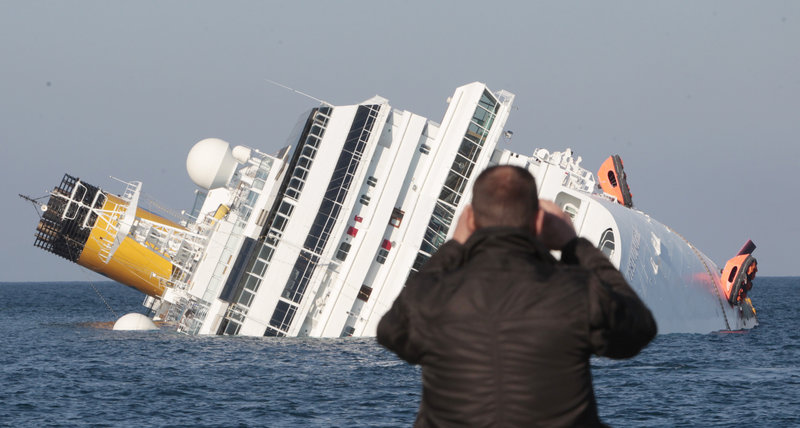PORTO SANTO STEFANO, Italy – The first course had just been served in the Costa Concordia’s dining room when the wine glasses, forks and plates of cuttlefish and mushrooms smashed to the floor.
At the magic show in the theater, the trash cans tipped over and the curtains turned on their side. Then the hallways turned upside down, and passengers crawled on bruised knees through the dark. Others jumped alone into the cold Mediterranean Sea.
The terrifying, chaotic escape from the luxury liner was straight out of a scene from “Titanic” for many of the 4,000-plus passengers and crew on the cruise ship, which ran aground off the Italian coast late Friday and flipped on its side with a 160-foot gash in its hull.
At least three bodies had been recovered and divers searched the underwater belly of the boat for a few dozen more who remained unaccounted for. By late Saturday, the number of missing had dwindled to about 40.
The Friday the 13th grounding of the Concordia was one of the most dramatic cruise ship accidents in recent memory. It immediately raised a host of questions: Why did it hit a reef so close to the Tuscan island of Giglio? Did a power failure cause the crew to lose control? Did the captain — under investigation on manslaughter allegations — steer it in the wrong direction on purpose? And why did crew members tell passengers they weren’t in danger until the boat was listing perilously to the side?
The delay made lifeboat rescue eventually impossible for some passengers, some of whom jumped into the sea while others waited to be plucked to safety by helicopters. Some boats had to be cut down with an axe.
“We had to scream at the controllers to release the boats from the side,” said Mike van Dijk of Pretoria, South Africa. “It was a scramble, an absolute scramble.”
Costa Crociera SpA, which is owned by the U.S.-based cruise giant Carnival Corp., defended the actions of its crew and said it was cooperating with the investigation. Carnival Corp. issued a statement expressing sympathy but didn’t address the allegations of delayed evacuation.
The captain, Francesco Schettino, was detained for questioning by prosecutors, investigating him for suspected manslaughter, abandoning ship before all others, and causing a shipwreck, state TV and Sky TV said. Prosecutor Francesco Verusio was quoted by the ANSA news agency as saying Schettino deliberately chose a sea route that was too close to shore.
Schettino’s attorney, Bruno Leporatti, told the agency: “I’d like to say that several hundred people owed their life to the expertise that the commander of the Costa Concordia showed during the emergency.”
France said two of the victims were Frenchmen; a Peruvian diplomat identified the third victim as Tomas Alberto Costilla Mendoza, 49, a crewman from Peru. Some 30 people were injured, at least two seriously.
A top Costa executive, Gianni Onorato, said Saturday the Concordia’s captain had the liner on its regular, weekly route when it struck a reef. Italian coast guard officials said the circumstances were still unclear, but that the ship hit an unknown obstacle.
Despite some early reports that the captain was dining with passengers when his ship crashed into the reef, he was on the bridge, Onorato said.
“The ship was doing what it does 52 times a year, going along the route between Civitavecchia and Savona,” Onorato told reporters on Giglio, a popular vacation isle off Italy’s central west coast.
He said the captain was an 11-year Costa veteran and that the cruise line was cooperating with Italian investigators to find out what went wrong.
Malcolm Latarche, editor of maritime magazine IHS Fairplay Solutions, said a loss of power coupled with a failure of backup systems could have caused the crew to lose control.
“I would say power failure caused by harmonic interference and then it can’t propel straight or navigate and it hit rocks,” Latarche said.
There were no firm indications that anyone was trapped. Rescuers carried out extensive searches of the waters near the ship for hours and “we would have seen bodies,” said Coast Guard Capt. Cosimo Nicastro.
Many passengers complained the crew didn’t give them good directions on how to evacuate and once the emergency became clear, delayed lowering the lifeboats until the ship was listing too heavily for many to be released.
Several other passengers said crew members told passengers for 45 minutes that there was a simple “technical problem” that had caused the lights to go off.
Seasoned cruisers knew better and went to get their life jackets from their cabins and report to their “muster stations,” the emergency stations each passenger is assigned to, they said.
Passengers said they had never participated in an evacuation drill, although one had been scheduled for Saturday. The cruise began on Jan. 7.
Coast guard Cmdr. Francesco Paolillo said the exact circumstances of the accident were still unclear, but that the first alarm aboard went off about 10:30 p.m., about three hours after the Concordia had begun its voyage from the port of Civitavecchia to Savona, in northwestern Italy. No SOS was sent, he said.
The vessel “hit an obstacle” that tore a 160-foot gash in the side of the ship, Paolillo said. It wasn’t clear if the obstacle was a jagged, rocky reef or something else, he said.
The captain, Paolillo said, then tried to steer his ship toward shallow waters, near Giglio’s small port, to make evacuation by lifeboat easier.
Send questions/comments to the editors.



Comments are no longer available on this story